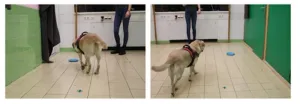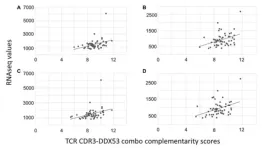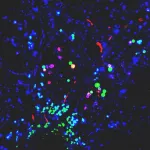(Press-News.org)
When we point at an object, the toddler focuses on the object, while the dog usually takes the gesture as a directional cue. In a recent study, researchers from the Department of Ethology at Eötvös Loránd University find explanations for this phenomenon. It appears that the discrepancy is not only due to how dogs see, but may, in fact, reflect how they think. For "smarter" dogs, the appearance of an object matters as much as its location, suggesting that their information processing is more similar to that of humans.
Spatial bias is the phenomenon of interpreting information in relation to space, location or distance when the same information could easily apply to an object. "This is manifested, for example, in the way dogs and children react to gestures when we show them the position of an object. Very early on, children interpret the gesture as pointing to the object, while dogs take the pointing as a directional cue. In other words, regardless of the intention of the person giving the cue, the meaning for children and dogs is different. This phenomenon has previously been observed in dogs using a variety of behavioural tests, ranging from simple associative learning to imitation, but it had never been studied per se," explains Ivaylo Iotchev, first author of the study, which appears in the journal Ethology.
The researchers have concluded that the spatial bias is an untapped opportunity to better understand how dogs think.
Previous research has not clarified whether dogs behave this way because they have inferior vision compared to primates, or whether it is actually an information processing bias, whereby the parameters of the space around them are more important to dogs than the specific, nearby objects.
The researchers measured spatial bias in two behavioural tests involving 82 dogs. In one task, the dogs had to learn, over a maximum of 50 trials, whether the treat was always on the right or left plate, so they learned a location. In the other task, two types of plates were used, a white round one and a black square one, these were always placed in the middle. A dog was always given only one type of plate to eat from but was exposed to each in a semi-random sequence. In this constellation, they were learning about the properties of the plate. Learning was measured by how fast a dog ran to the correct plate. The results showed that the animals learned faster when the treat was placed to the right or left, so they had to choose which direction to go. They had more difficulty remembering whether the treat was on the white round or black square plate. The 'spatial bias' measure described how much faster the dogs were at learning about the place than at learning about object features. A more complicated task followed if the dogs had already learned where the treat was because then the situation was reversed. That is, if they had previously received the treat on the right, it was now on the left in the new position, and if it had been on the white plate, it was now on the black plate.
To find out whether spatial bias is sensory, cognitive or mixed, the researchers needed to detect and measure differences between the visual and cognitive abilities of dogs.
This involved measuring how short the dog's head is - as this is correlated with visual acuity - and also measuring how efficiently they solve problem tasks.
The head shape was investigated by Zsófia Bognár PhD student and co-author of the study. "The visual abilities of dog breeds differ from each other, which indirectly results from their head shape. Dogs with shorter heads - scientifically known as brachycephalic - develop human-like vision. The structure of their retina implies sharper and more focused vision than their longer-headed counterparts. This has allowed us to use a measure of head shape (the so-called "cephalic index") as an approximate measure of the quality of vision in dogs. It is calculated by dividing the width of the skull by the length of the skull. The shorter the head, the higher the number", explained Zsófia Bognár.
To measure cognitive ability, the dogs took part in a series of tests. "We tested their memory, attention skills and perseverance. We found that dogs with better cognitive performance in the more difficult spatial bias task linked information to objects as easily as to places.
We also see that as children develop, spatial bias decreases with increasing intelligence,"
adds Eniko Kubinyi, head of the MTA- ’Lendület’ Momentum Companion Animal Research Group.
The study found that spatial bias is smaller in dogs with better visual acuity and who are "smarter". "Spatial bias in dogs is not simply a sensory problem but also a mindset. We also found that 'smarter' dogs are resilient in difficult learning situations and can overcome their biases," concludes Iotchev.
END
“In this ESCA study, the possibility of an immune response that selected for tumor cells lacking the DDX53 CTA is discussed.”
BUFFALO, NY- November 17, 2023 – A new research paper was published in Oncoscience (Volume 10) on November 10, 2023, entitled, “An immunoinformatics assessment of the cancer testis antigen, DDX53, as a potential early esophageal cancer antigen.”
T-lymphocytes have been implicated in facilitating a pro-inflammatory, pro-tumorigenic microenvironment that worsens prognosis for esophageal carcinoma (ESCA). In their new study, researchers ...
To reduce the side effects associated with chemotherapy treatments, researchers have investigated the use of delivery systems that can take more drugs directly to the tumor. Ninh (Irene) La-Beck, Pharm.D., from the Department of Immunotherapeutics and Biotechnology at the Texas Tech University Health Sciences Center (TTUHSC) Jerry H. Hodge School of Pharmacy is one of those researchers.
La-Beck recently received a five-year, $2.49 million grant (“Cholesterol Metabolism in the Pharmacology of Liposomal ...
Earth science researcher Dr. Antonia Gambacorta earned the 2023 Goddard IRAD Technology Leadership award for pioneering new ways to measure lower layers of Earth’s atmosphere from space.
The award from the chief technologist of NASA’s Goddard Space Flight Center in Greenbelt, Maryland, recognizes Gambacorta’s work demonstrating how hyperspectral microwave sounding, the measurement of hundreds of thousands of wavelengths of microwave light, could dissect Earth’s atmospheric planetary boundary layer (PBL). She also ...
BOSTON – Glaucoma is one of the leading causes of blindness worldwide, and vision loss, due to the loss of retinal ganglion cells (RGCs), cannot currently be reversed with any treatment. Some studies have looked at replacing RGCs through cell transplants, but this process is still in the research and development stage and fraught with limitations that highlight a need for a more precise manner of effectively repopulating these cells in the retina. Now, a multidisciplinary team led by researchers at the Schepens Eye Research Institute of Mass Eye and Ear has ...
Rochester Institute of Technology’s Emiliano Brini, assistant professor in the School of Chemistry and Materials Science, has received an award from the National Institutes of Health (NIH) to support his research on building the next generation of drugs.
Brini and his team of students will develop computational tools that can predict the strength of the interaction between two proteins and how drugs will modify this interaction. Physics-based methodologies will quickly and accurately provide such predictions.
Designing a new ...
Small molecules called immunomodulators can help create more effective vaccines and stronger immunotherapies to treat cancer.
But finding the molecules that instigate the right immune response is difficult —the number of drug-like small molecules has been estimated to be 1060, much higher than the number of stars in the visible universe.
In a potential first for the field of vaccine design, machine learning guided the discovery of new immune pathway-enhancing molecules and found one particular small molecule that could outperform the best immunomodulators on the market. The ...
Seven scientists from the Department of Energy’s Oak Ridge National Laboratory have been named among the world’s most influential researchers on the 2023 Highly Cited Researchers list, produced by Clarivate, a data analytics firm that specializes in scientific and academic research.
"These scientists have delivered significant impact for the scientific community and nation," said ORNL Director Stephen Streiffer. "This honor highlights their commitment, hard work and leadership in their respective fields.”
The ORNL researchers named to the list are:
Miaofang Chi, Center for Nanophase Materials Sciences
David A. Cullen, Center for Nanophase Materials ...
A new understanding of lung cancer cells’ “memories” suggests a new strategy for improving treatment, Memorial Sloan Kettering Cancer Center (MSK) researchers have found.
Research from the lab of cancer biologist Tuomas Tammela, MD, PhD shows that some lung cancer cells retain a “memory” of the healthy cell where they came from — one that might be exploited to make an emerging type of lung cancer treatment called KRAS inhibition more effective.
The study looked specifically at lung adenocarcinoma, a type of non-small ...
When Cyclone Idai swept through Mozambique’s Gorongosa National Park in May 2019, one of nature‘s deadliest forces encountered one of the most technologically sophisticated wildlife parks on the planet. Princeton researchers and colleagues from around the world documented the effects using trail cameras and animal-tracking devices that had been in use before the storm.
Thanks to the extensive network of cameras, GPS collars and other instruments, park staff and ...
DURHAM, N.C. – Nanoplastics interact with a particular protein that is naturally found in the brain, creating changes linked to Parkinson’s disease and some types of dementia.
In a Duke-led study appearing Nov. 17 in Science Advances, the researchers report that the findings create a foundation for a new area of investigation, fueled by the timely impact of environmental factors on human biology.
“Parkinson’s disease has been called the fastest growing neurological disorder in the world,” said principal investigator, Andrew West, Ph.D., professor in the Department of Pharmacology and Cancer Biology at ...










